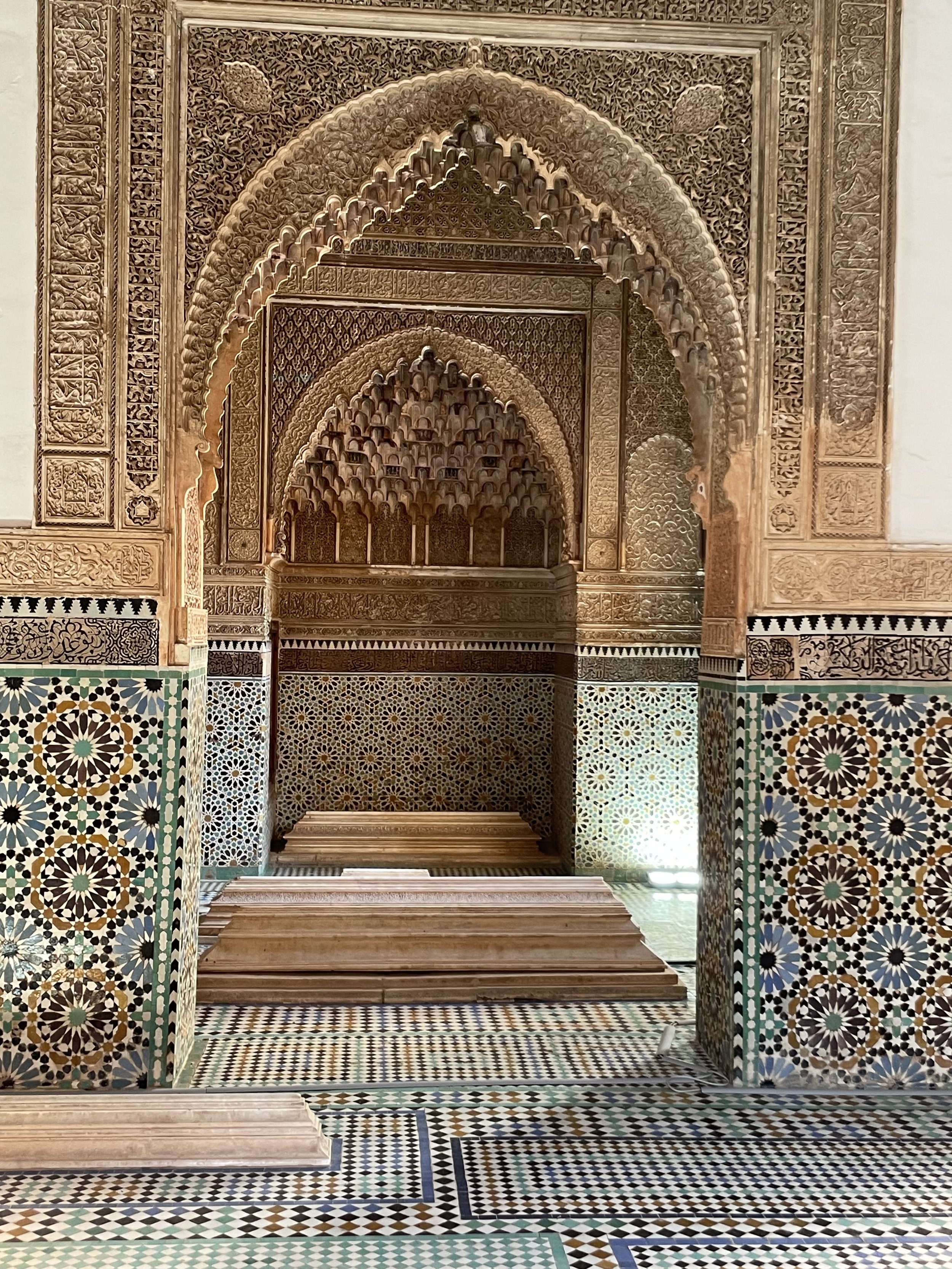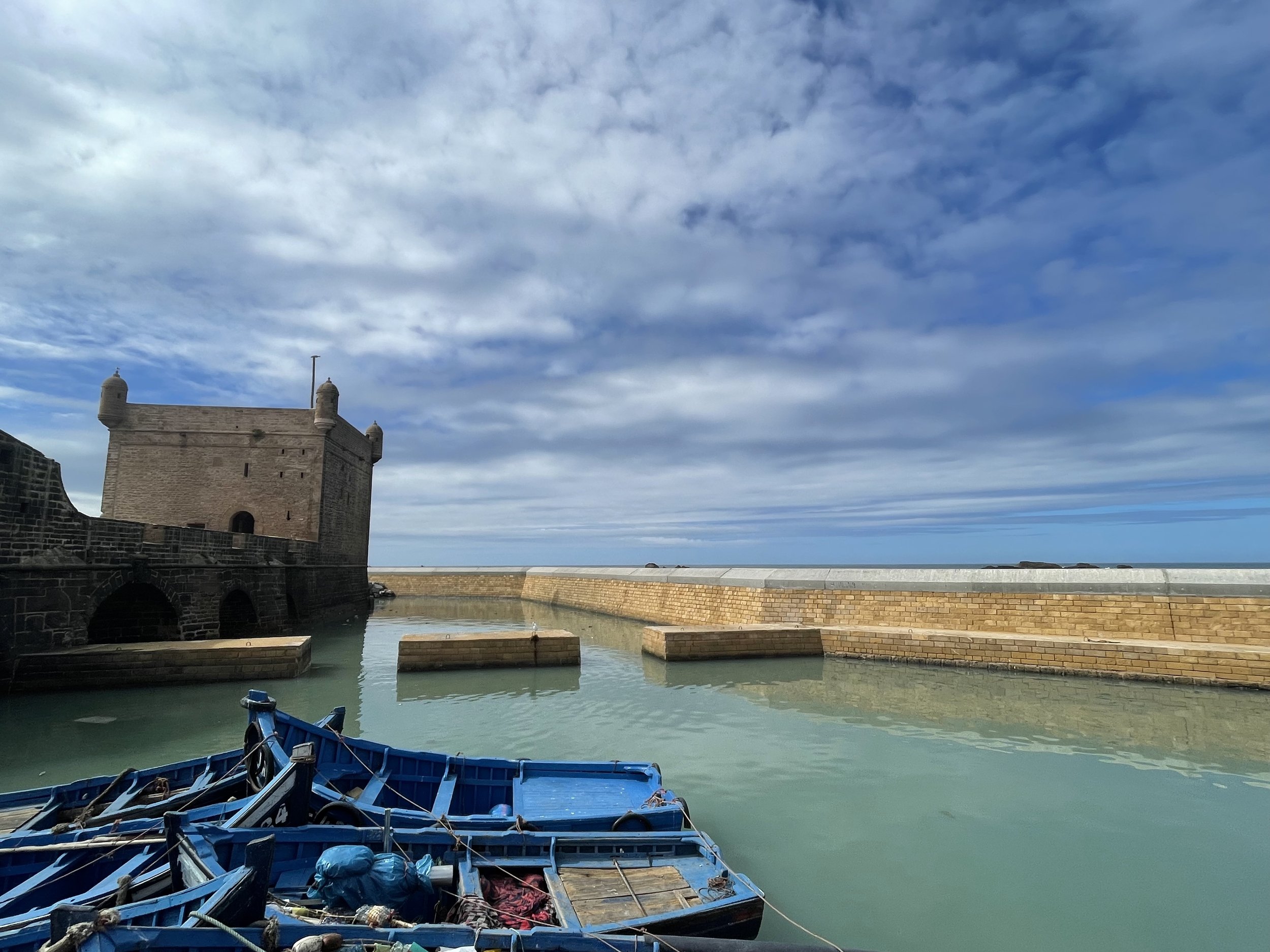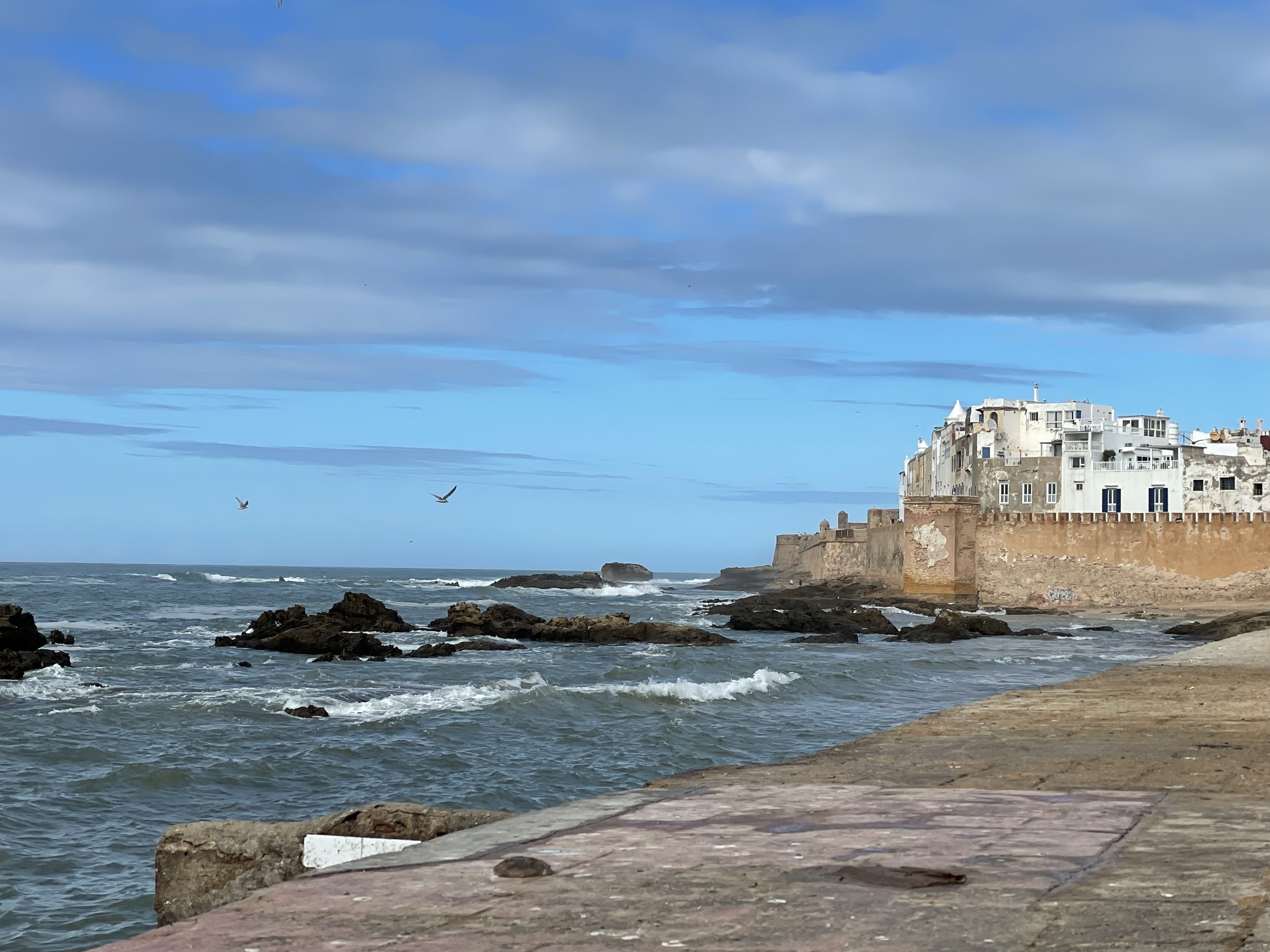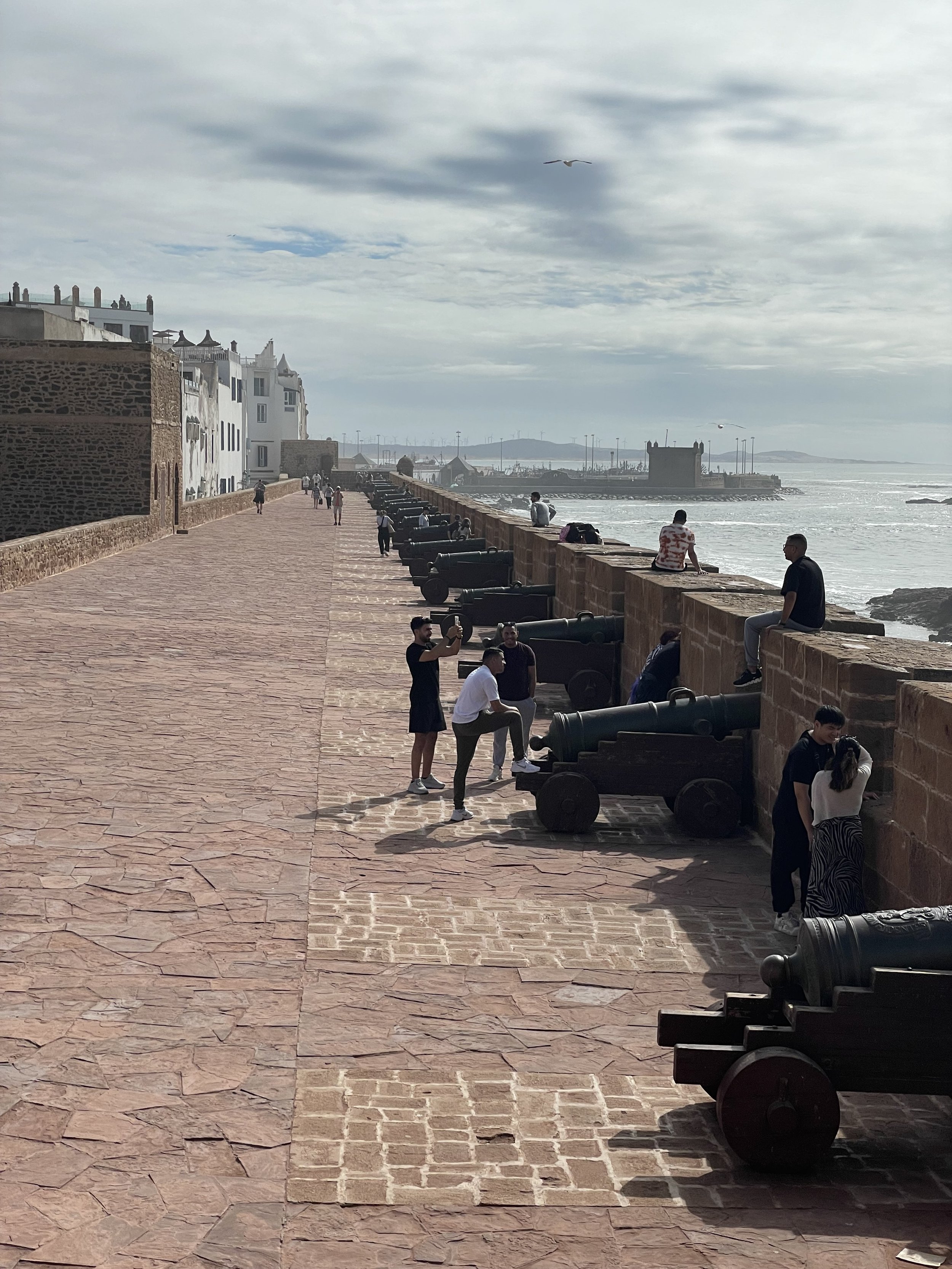Morocco | Marrakesh, Essaouira & The Atlas Mountains
The more we push ourselves out of our own comfort zone, the more rewarding the experience has been. This couldn’t have been more true of our time in Morocco.
Beautiful door at the Koutoubia Mosque in Marrakesh, Morocco.
Our Morocco Itinerary:
Day 1: Arrive (late night) in Marrakesh and to Riad Djemanna
Day 2: Historical Tour of Marrakesh and Explore the Medina
The Saadien Tombs: The Saadian Tombs are a symbol of the Saadian dynasty’s power, wealth, and devotion to Islam. Interestingly, the tombs were sealed off and hidden for centuries after the Saadians fell from power. The tombs remained hidden until 1917 and largely unknown until an aerial survey during the French Protectorate revealed their location, and a narrow passage was cut through the surrounding wall.
The Saadian Tombs
The Saadian Tombs
Chamber of the 12 Columns: This is the most famous and ornate room in the tomb complex. It features 12 Carrara marble columns and a stunning cedarwood ceiling, housing the grave of Sultan Ahmed al-Mansou.
Chamber of the 12 Columns
The Garden Area: Outside the mausoleums, the garden contains over 100 smaller graves, marking the resting places of Saadian princes, soldiers, and royal family members. These graves are often decorated with simple zellij tiles.
Garden area graves in the Saadian Tombs.
The Saadian Tombs remain a breathtaking example of Morocco’s rich cultural and artistic heritage, offering visitors a glimpse into the opulence of the Saadian dynasty and their lasting imprint on Marrakesh.
The El Badi Palace (or Palais El Badiî): The El Badi Palace is a magnificent historical site in Marrakesh, symbolizing the opulence and grandeur of the Saadian dynasty during its peak in the late 16th century. It was primarily used as a lavish royal residence and a venue for grand ceremonies and state functions. Although now in ruins, the palace remains a fascinating destination, showcasing the wealth, artistic vision, and architectural brilliance of its era.
After the fall of the Saadian dynasty, the El Badi palace was stripped of its materials by the Alaouite Sultan Moulay Ismail in the late 17th century. He repurposed them for his new capital in Meknes, leaving El Badi a shell of its former glory.
Bahia Palace in Marrakesh, Morocco
Bahia Palace outdoor meeting spaces for guests to meet with royalty.
Bahia Palace common spaces for guests when they visited.
Bahia Palace: The Bahia Palace is one of the most stunning and historically significant landmarks in Marrakesh, Morocco. Built in the late 19th century, it is a masterpiece of Moroccan and Islamic architecture. It reflects the lifestyles of Morocco’s elite and provides insight into the political and social structures of the time.
Bahia Palace woodwork detailing.
Day 3: Explore the Mosque, Medina and Food Tour
Koutoubia Mosque: The Koutoubia Mosque is one of the most iconic landmarks in Marrakesh, Morocco a symbol of Marrakesh’s enduring history and cultural richness. The mosque dominates the Marrakesh skyline, with the distinctive three golden balls atop the minaret.
Koutoubia Mosque
Koutoubia Mosque
Jeremy and Valerie at the Koutoubia Mosque
The Medina of Marrakesh: The Medina a UNESCO World Heritage Site since 1985, is the historic heart of the city and one of the most vibrant and culturally rich areas in Morocco. Dating back to the 11th century, the Medina is a labyrinth of narrow alleyways, bustling markets, historic landmarks, and traditional Moroccan homes (riads), reflecting centuries of history, architecture, and daily life.
Jemaa el-Fnaa — The central square and beating heart of the Medina, Jemaa el-Fnaa is one of the most famous public spaces in the world. By day, it is filled with juice vendors, henna artists, and snake charmers. By night, it transforms into a lively scene with food stalls, musicians, storytellers, and entertainers.
Souks (Markets) — The Medina is home to a network of souks, each specializing in specific goods:
Souk Semmarine: Traditional clothing and textiles.
Souk El Attarine: Perfumes and spices.
Souk Chouari: Wooden crafts and furniture.
Souk Smata: Babouches (Moroccan slippers).
These markets are a sensory overload of colors, scents, and sounds, offering everything from leather goods and pottery to carpets and jewelry.
Walking through the Souk
Jemaa el-Fnaa at night
Food Tour: Taking a food tour is ideal as you get to taste unique food of this ancient city, interact with locals and visit some of the best food markets and street stalls. It’s madness, but there are so many amazing things to see and taste. We did a food tour and ate two wonderful traditional Morrocan dishes:
The tangiah we had during our food tour at one of the food stalls in the Jemaa el-Fnaa.
Tangiah, which is sort of like a tagine, but it is essentially meat, oil and whatever special mixture of spices each vendor uses that is cooked in a clay pot for 12+ hours. It falls apart and the flavors are so intensely concentrated you can’t help but want to eat more.
M’smen, which is a flat bread that is rolled out thin, thicker than a tortilla, but thinner than Naan, that is then grilled on a flat top. It is often served plain for breakfast, but the real deliciousness is when they add either this mixture of seasoned, finely minced meat (almost like a paste) or this blended up mixture of tomatoes, olives, garlic and other veggies. Even Jeremy liked the latter and half of the ingredients he normally dislikes. It tastes like a Moroccan quesadilla!
Day 4: Day on Our Own — Desk for the Day working with kitties
Desks for the Day at the riad in Marakesh, Morocco.
Valerie’s work helper for the day.
We all need down days and time to get some work done. This was one of our ‘Desk for a Day’ days. There are kitties all over the city, but the riad had two cats as pets who loved to be loved by Valerie.
Day 5: Drive from Marrakesh to Essaouira and Walking Tour of Essaouira
Essaouira is approximately a three hour drive from Marrakesh. As a port town with a strategic position off the North Atlantic coast, Essaouira’s port has always been at the forefront of the town’s history. Today, the port is still used as a base for both local and international fisherman. Compared to Marrakesh, it is a quiet beach/fishing town on the south west coast of the country.
View from our room of the Essaouira coast.
Essaouira’s ramparts are well preserved and offer striking views of the town’s fortified walls as they meet the rugged waves of the North Atlantic. The ramparts are home to many of Essaouira’s local population, who take time out of their day to perch on the cannons that once defended the town’s wall, adding to the ambience of this breathtaking location. By chance, it was another place where Game of Thrones used for filming.
Essaouira used to be called Mogador. This is one section of the ancient ramparts guarding the old city. Game of Thrones shot scenes at this fortress. The blue boats are the traditional fishing boats still used by the locals to this day!
Mogador fortress wall
Essaouria coastline with protective walls.
Mogador Ramparts with cannons
Essaouira’s medina reflects the town’s laid back atmosphere and feels spacious in comparison to the intimate labyrinthine medinas of Marrakesh. Full of musicians and artists painting, weaving carpets, making pottery and hand crafting wood into the most beautiful and intricate wares. If we had a home to get back to following our time here, we would have bought A LOT of beautiful things in the medina.
Essaouira Medina street with traidional white and blue painted buildings.
A man and his spices! Local spice shop in the Essaouira Medina. So many good spices!
Kitty living his best life on the streets of Essaouira with a full belly of fresh fish.
Day 6: Cooking Workshop in Essaouira and explore Essaouira
Speaking of cooking, we did a cooking workshop in Essaouira where we made shakshuka and delicious beef tagine!
Oh the spices we got to cook with!
Prep area for the cooking class.
Valerie and Jeremy at the cooking class in Essaouira, Morocco.
We love to cook, and we have made a few recipes describing themselves as “Morrocan,” but didn’t really know what to expect food-wise outside of what we might have seen on television. It is so much more than just the food itself! Morrocans really wanted to feed you and make you feel welcome from the moment you enter their restaurant, or shop. You are almost always greeted with mint tea and some sort of small spread of breads, jams and honey.
Valerie’s tagine cooking (name written in Arabic).
Jeremy’s tagine cooking (name written in Arabic).
We learned how to make roses out of a tomato peel.
The finished product of the beef tagine!
Day 7: Drive from Essaouira to the High Atlas Mountains and settle in at Kasbah Angour
Kasbah Angour is a property based on an Amazigh castle, just a half an hour drive from Marrakesh. With a spectacular location perched on a hilltop in the foothills of the High Atlas Mountains, the kasbah has superb panoramic views. To the south and east are the peaks of the highest mountains in Morocco, including Angour, Oukaimeden and the Toubkal Massif. To the north and west is the river Sidi Fares Valley, with its olive groves and villages built from compacted earth.
Kasbah Angour perched up on its hill.
Day 8: Half Day Hike in the High Atlas Mountains
Hiking the Atlas mountains was a wonderful way to see the panoramic views of the Atlas peaks. It was quiet and the weather was perfect. If you look closely, you can find clues to locate ancient Roman treasures!
View from the kasbah over the village of Toufssirine
Village in the Atlas Mountains along our hike.
A clue to find ancient Roman treasures! (if you believe our guide 😂)
Sunrise over the Atlas Mountains foothills, Morocco
Day 9: Day in the Life of the Amazigh
With a tour guide we traveled through lush farmland and dramatic hillscapes of the High Atlas Mountains to reach Ait Ouamden, a modest Amazigh village. We spent the day with a local family and learned how to bake Amazigh bread and a chicken tagine. As lunch cooked, we explored the village and learned about how the locals live in the village. Lastly, we ate a delicous lunch, that we cooked, with the family whom hosted us.
Front door the the Amazigh family home.
Amazigh family baking Amazigh bread in their stove.
Ta da! The final product — our chicken tangine.
View from bake Amazigh village toward Marrakesh.
Our chicken tangine cooking!
Donkey caring goods through the village.
Beautiful Atlas Mountains, with just a bit of snow.
Day 10: Fly from Morocco to London
Things We Learned:
Be prepared to spend two hours in the Marakesh airport to get through passport control and customs. It is a tedious and slow process. We heard from the owner of the kasbah we stayed at in the Atlas Mountains that most of the delay is that their computer systems are slow. So when you think they are just taking their time, they are actually waiting for the computer to refresh with the next screen of information they need to let you through. Leaving is no different, get to the airport early as you need to have your bags scanned to even get into the airport, then again through security and finally exiting passport control.
Arriving in Morocco we were a bit worried about navigating the medina (central old part of the city). This is not only the main touristy area and there are a loooooot of people, but people who have been here all warned how overwhelming it can be with vendors constantly in your face, trying to pull you into their stall to buy things. We were told that they can be aggressive, and just roll with it. However, this was not our experience. There were definitely vendors here and there who tried to spark conversation or get us to “just look, no pressure to buy,” but for the most part we were left alone as we wandered. We originally thought it might have been because we had a local guide on the first day we ventured out, but we found it no different when we were wandering around on our own.
Everything from trucks, to small motorbikes, mopeds, bicycles, oxen and donkeys pulling carts are everywhere in the medina in Marrakesh, The most precarious part was that the mopeds in particular weaved through the very crowded Souk. Honestly, we found this more concerning than vendors being pushy, or even pick-pockets. The nice thing was that when we got to Essaouira, we found out that anything with an engine is forbidden in the entire medina. And that made for much more relaxing strolls around town in Essaouria.
Hello from Morocco!
That is a snapshot of our time in Morocco. Bssaha (cheers) to a wonderful experience in this beautiful country.
Now…Where To Next?













































